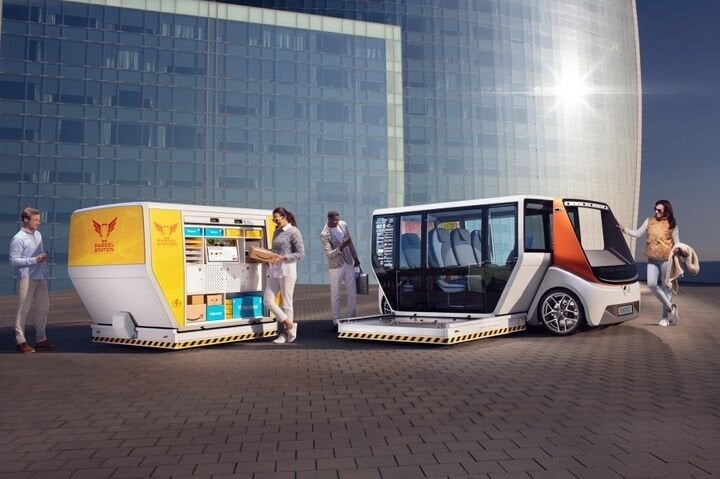![The MetroSnap concept electric vehicle [Source: Rinspeed]](https://fabbaloo.com/wp-content/uploads/2020/05/image-asset_img_5eb08c0a9b23d.jpg)
Stratasys revealed some work the 3D printing giant had done to assist in the development of a concept car, but I realized this shows how the future will play out.
Stratasys partnered with Switzerland-based Rinspeed to develop a concept vehicle called “MetroSnap”. This electric vehicle is intended to operate autonomously, and derives its name from the method of electricity recharge.
The MetroSnap is designed to use a hot-swappable battery pack in a modular way. The vehicle can, in only minutes, replace the batteries with a fully charged set and be on its way, thus avoiding lengthy recharging delays.
3D Printing MetroSnap
But I’m not particularly interested in the vehicle itself; rather I am interested in how Stratasys helped the project move forward. They say:
“Over 30 interior and exterior parts were customized using both Stratasys’ FDM and PolyJet technologies, including everything from interior consoles, display frames, plug socket fixtures and air vents, right through to the lidar screens and licence plate on the exterior.”
And:
“The MetroSnap features a unique swapping system, which sees the vehicle body ‘Pod’ and chassis ‘Skateboard’ operating independently on split batteriesDuring the development of the Pod, the team leveraged Stratasys FDM additive manufacturing to 3D print bespoke parts that were not only fit-for-function, but importantly had the material properties required for an end-use automotive environment. One such example is the middle console of the Pod, which needs to be durable yet lightweight in order to maximize fuel and speed efficiencies. To achieve a high stiffness-to-weight ratio and structural strength, the part was 3D printed in Nylon12CF material, which combines both carbon-fiber and Nylon 12.
Sensor covers on the MetroSnap, 3D printed in Stratasys’ ASA material which offers advanced properties that can withstand extreme weather and UV-radiationAnother example can be seen on the outside of the Pod, where Stratasys’ ASA material was used to 3D print sensor covers able to perform like a traditionally manufactured version, specifically offering advanced properties to withstand extreme weather conditions and UV-radiation. The parts were printed in a matter of hours, saving the project valuable production time compared to traditional methods or lengthy post-processing.
For the vehicle interior, Stratasys’ newly-launched J850 3D Printer was used, offering Rinspeed unique multi-material, full Pantone-validated color 3D printing capabilities. This was integral in being able to quickly produce ultra-realistic interior parts that closely matched the strict design criteria of the MetroSnap, both in terms of customized ergonomic shapes and color aesthetics.”
This work allowed the project to continue quite quickly, as they did not have to wait significantly for traditional production of these parts, which were simply 3D printed on demand. That’s the well-known value of the technology to rapid prototyping that many projects have benefited from over decades.
But there’s more here.
3D Printing Multiple Processes
You’ll notice that Stratasys applied multiple processes and materials to the project. They were able to build strong parts for certain requirements, while others were made with brilliant colors for aesthetic purposes.
It’s as if an advanced 3D printing crew arrived with a set of powerful tools and built a large subset of the parts required to build the entire vehicle. Although it’s not stated by Stratasys, the 3D printed parts likely were a notable proportion of the total number of parts for the vehicle.
That percentage would not be 100%, but it’s a lot more than zero.
3D Printing Car Parts
Here’s what I am thinking: what if we tracked that percentage over time? It’s likely the percentage of 3D printed parts would increase over time, with an increasing proportion of the vehicle / project being 3D printed. This is due to projected advancements in 3D printing processes and available 3D printable materials.
Now consider this: some people talk about the fantasy of a “3D printed car”.
It is a fantasy, at least at this point. In order to literally 3D print an entire vehicle you would need to develop some kind of magic 3D printing process that could handle multiple arbitrary materials, all in the same print job. I can’t see that happening for a very long time, and will depend on researchers developing new ways to 3D print.
But what will happen is this: the proportion of 3D printed parts on a vehicle or other similar projects will gradually increase.
At some point the majority of parts could be 3D printed. Eventually it might even be conceivable all of the parts could be 3D printed.
If 100% of the parts of a car are 3D printed, have we 3D printed a car? Maybe, but what’s really going on here is that we are not “3D printing a car”. We are 3D Printing Car Parts.
That’s what our machines make: parts. They rarely if ever make entire machines, and never entire vehicles. They make parts.
Now, we just have to directly integrate them with assembly robots, and then we’ll have the entire sequence.
Via Rinspeed

